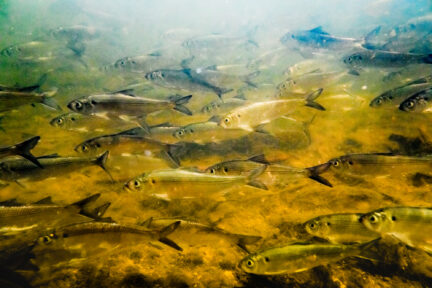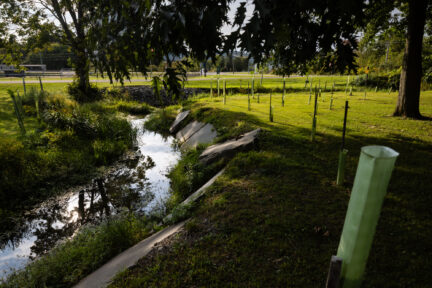Chesapeake Bay "dead zone" predicted to be 13% lower than average
Low oxygen conditions also expected to start later in the season
Researchers from the Chesapeake Bay Program, the University of Maryland Center for Environmental Science, University of Michigan and U.S. Geological Survey announced today that they are predicting this summer’s dead zone to be smaller than the long-term average taken between 1985 and 2021. This is due to the below average amount of water entering the Bay from the watershed’s tributaries this past spring, as well as decreased nutrient and sediment pollution from jurisdictions within the watershed.
Areas of low oxygen, also known as hypoxic regions, are often considered to have dissolved oxygen concentrations less than 2 mg/L (milligrams per liter) and are primarily caused by excess nutrient pollution flowing into the Bay. These regions can result in the loss of habitat for various types of marine life, including fish, blue crabs, oysters and underwater grasses.
Compared to the previous 36 years, this year’s Chesapeake Bay hypoxic volume, or “dead zone”, is predicted to be 13% lower than average. This is similar to last year, when the hypoxic volume was predicted to be 14% lower than the average. For the past three years, the dead zone has been forecasted to be lower than the long-term average—and in all cases, the forecasts proved accurate when compared to data collected throughout the summer.
In 2022, summer hypoxia also began later than it had in several previous years. In 2021, 2019, 2018 and 2017, hypoxic conditions began in mid to late May, but in 2022, hypoxia was not apparent in the Bay until early June. This late start is largely due to cooler temperatures in May when compared to other years.
The levels of pollution reaching the Chesapeake Bay each year vary due to the amount of spring rainfall impacting river flows, which flushes excess nutrients and sediment into the water, as well as conservation practices implemented by jurisdictions to reduce and manage those pollutants.
Although different types of nutrients contribute to the annual dead zone, it is the amount of nitrogen that enters the Bay during spring that is a key driver in how hypoxic conditions can vary from year-to-year. The amount of nitrogen pollution entering the Bay during spring 2022 was 22% lower than the long-term average and included 102 million pounds of nitrogen recorded at nine river input monitoring stations and 5.7 million pounds from treated wastewater. There was 5% less water flowing into the Bay when compared to the long-term average.
A Bay-wide assessment of the 2022 dead zone will be available this fall.
Facts
Throughout the year, researchers measure oxygen and nutrient levels as part of the Chesapeake Bay Monitoring Program, a Bay-wide cooperative effort involving watershed jurisdictions, several federal agencies, 10 academic institutions and over 30 scientists. Among these institutions, the Maryland Department of Natural Resources and Virginia Department of Environmental Quality conduct 8-10 cruises between May—October, depending on weather conditions, to track summer hypoxia in the Bay. Results from each monitoring cruise can be accessed through the Eyes on the Bay website for the Maryland portion of the Bay and the VECOS website for the Virginia portion. The U.S. Geological Survey monitors river flow, nutrients and sediment entering the Bay at the nine river input monitoring stations.
A model developed by the University of Michigan has been used since 2007 to forecast the volume of summer hypoxia for the mainstem of the Chesapeake based on the amount of nitrogen pollution flowing into the Bay from nine river monitoring stations and the wastewater treatment plants that are located downstream of them. The hypoxia forecast model, enhanced in 2020, allows for projections for an average July, average summer and the total annual hypoxic volume, and is based on the monitoring of nitrogen pollution and river flow at the nine river input monitoring stations along the Appomattox, Choptank, James, Mattaponi, Pamunkey, Patuxent, Potomac, Rappahannock and Susquehanna rivers. Together, the U.S. Geological Survey, in partnership with Maryland and Virginia, monitor nitrogen pollution and other important pollutants, flowing into the Bay from 78% of the watershed. In the area not monitored by these stations, additional pollution reported from wastewater treatment plants are also included in the model.
Each of these models and forecasts are supported by the most up-to-date river flow and nutrient inputs from the U.S. Geological Survey. Scientists at the Virginia Institute of Marine Science, in collaboration with Anchor QEA, produce daily real-time estimates of hypoxia volume that show levels beginning later in 2022 when compared to recent years, consistent with monitoring data.
Funding for the models has come from the National Oceanic and Atmospheric Administration and data used by the models are provided by the U.S. Geological Survey, Maryland Department of Natural Resources, Virginia Department of Environmental Quality and Chesapeake Bay Program.
Issues
The dead zone is an area of little to no oxygen that forms when excess nutrients, including both nitrogen and phosphorus, enter the water through polluted runoff and feed naturally-occurring algae. This drives the growth of algae blooms, which eventually die and decompose, removing oxygen from the surrounding waters faster than it can be replenished. This creates low-oxygen—or hypoxic—conditions. Plant and animal life are often unable to survive in this environment, which is why the area is sometimes referred to as a “dead zone”.
Pollution reducing practices used in backyards, cities and on farms can reduce the flow of nutrients into waterways. Management actions taken to decrease loads from point sources (e.g., wastewater treatment plants) may immediately show detectable pollution changes, but regarding the implementation of best management practices for non-point sources, there is often a lag in measuring their impact on improving water quality and the health of the Bay.
Weather conditions also play a role in the size and duration of the annual dead zone. Heavy rainfall can lead to strong river flows entering the Bay, which carries along increased amounts of nutrient and sediment pollution. Above average spring freshwater flows to the Bay, along with hot temperatures and weak winds in the summer, provide the ideal conditions for the dead zone to grow larger and last longer.
Quotes
“The fact that hypoxia in the Bay is once again forecasted to be lower than the long-term average is clearly a positive sign for Bay restoration. When we consider that hypoxia is continually being exacerbated by marine heat waves and warmer Bay waters, this recent success of our nutrient management efforts is even more impressive.”
- Dr. Marjy Friedrichs, Research Professor, Virginia Institute of Marine Science
“Dissolved oxygen levels are a key measure of Bay health, as sufficient oxygen is needed to support vital fish, crab and oyster populations, as well as a healthy ecosystem. The forecast brings attention to our continued progress towards implementation of nutrient reduction strategies to improve oxygen conditions. The Maryland Department of Natural Resources looks forward to working with our Chesapeake Bay Program partners to monitor and report on hypoxic levels throughout the summer.”
- Mark Trice, Water Quality Program Manager, Department of Natural Resources, State of Maryland
“Hypoxia forecasts are a critical part of the scientific process that supports Bay restoration. This annual partnership continues to refine the link between watershed conditions and Bay health.”
- Joel Blomquist, Hydrologist, U.S. Geological Survey
“This summer is shaping up to be similar to 2020, when hypoxia conditions were relatively good compared to the long-term average and the recent past. We will have to wait and see how weather during the summer of 2022 impacts the total amount of hypoxia, but the Bay is off to a promising start to the summer.”
- Dr. Aaron Bever, Managing Scientist, Anchor QEA



